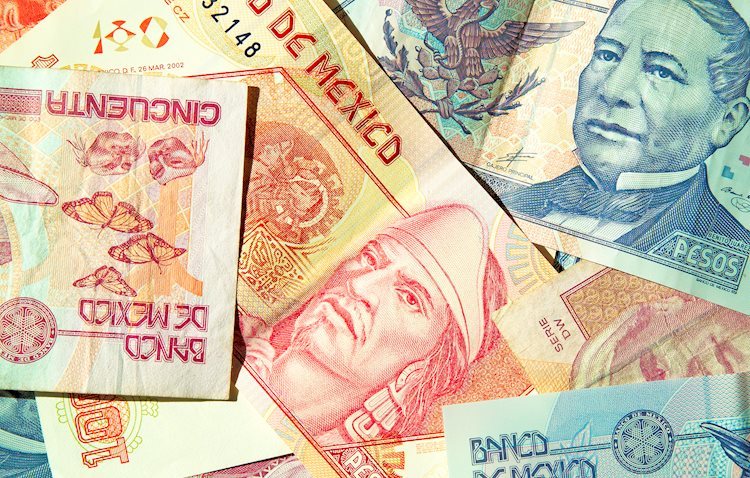- Mexican Peso on the front foot following as Sheinbaum’s take office.
- Traders await President-Elect Claudia Sheinbaum’s inaugural remarks.
- Stronger than expected US JOLTS data and Powell’s comments support a bullish bias in USD/MXN.
The Mexican Peso erased some of its earlier losses versus the US Dollar on Tuesday as President Claudia Sheinbaum delivered her first speech in the General Session of the Mexican Congress. The Peso recovered some ground as Sheinbaum’s reassured investors that its investments remain secure. Therefore, the USD/MXN dropped some 0.25% and traded at 19.63 amid heightened tensions in the Middle East.
Wall Street reflects a downbeat market mood due to heightened geopolitical risks. This sparked flows toward the Greenback due to its safe-haven status, which was detrimental to the Peso’s emerging market status.
Mexico’s economic docket remains absent, with traders awaiting remarks from President Claudia Sheinbaum as she takes office. Across the north of the border, the US schedule featured the release of the August JOLTS report, which was better than expected and exceeded the July number.
The Institute for Supply Management (ISM) revealed the September Manufacturing PMI, which remained in contractionary territory but was unchanged compared to August.
On Monday, Federal Reserve (Fed) Chair Jerome Powell revealed that the central bank is in no rush to lower borrowing costs while foreseeing 50 basis points of easing toward the end of 2024.
Given the backdrop, the USD/MXN is expected to remain upwardly biased after Powell resisted expectations of aggressive easing by the Fed.
Daily digest market movers: Mexican Peso advances despite geopolitical risks
- Mexican political turmoil eases as market participants prepare for the change of president on October 1, a bank holiday in Mexico.
- According to the swaps markets, Banxico is expected to lower borrowing costs by 175 bps by the end of 2025.
- The US Department of Labor revealed that the August Job Openings & Labor Turnover Survey (JOLTS) increased from 7.711 million to 8.04 million, exceeding estimates of 7.655 million.
- The ISM Manufacturing PMI in September rose by 47.2, unchanged from the previous reading, but it missed estimates of 47.5.
- Last week Atlanta Fed President Raphael Bostic commented that he will closely monitor jobs data to assess the Fed’s policy stance. He indicated that he is open to cutting rates by 50 basis points (bps) while acknowledging that he is not yet ready to declare victory on inflation.
- Market participants have put the odds of a 25 bps cut at 61.6%. According to the CME FedWatch Tool, the chances for a larger 50 bps cut diminished to 38.4%.
USD/MXN technical analysis: Mexican Peso gains as USD/MXN drops toward 19.60
The USD/MXN uptrend remains intact and resumed for the fifth consecutive day, with buyers gaining momentum. The Relative Strength Index (RSI) shows that bulls are in charge. This means that the exotic pair could test higher prices in the near term.
If USD/MXN clears the psychological 20.00 figure, the next resistance would be the YTD peak of 20.22. Further strength will expose the September 28, 2022, high of 20.57, followed by the 21.00 mark.
Conversely, If USD/MXN drops below 19.50, the next support would be the September 24 swing low of 19.23 before the pair moves toward the September 18 low of 19.06. Once those levels are surpassed, the 19.00 figure emerges as the following line of defense.
Risk sentiment FAQs
In the world of financial jargon the two widely used terms “risk-on” and “risk off” refer to the level of risk that investors are willing to stomach during the period referenced. In a “risk-on” market, investors are optimistic about the future and more willing to buy risky assets. In a “risk-off” market investors start to ‘play it safe’ because they are worried about the future, and therefore buy less risky assets that are more certain of bringing a return, even if it is relatively modest.
Typically, during periods of “risk-on”, stock markets will rise, most commodities – except Gold – will also gain in value, since they benefit from a positive growth outlook. The currencies of nations that are heavy commodity exporters strengthen because of increased demand, and Cryptocurrencies rise. In a “risk-off” market, Bonds go up – especially major government Bonds – Gold shines, and safe-haven currencies such as the Japanese Yen, Swiss Franc and US Dollar all benefit.
The Australian Dollar (AUD), the Canadian Dollar (CAD), the New Zealand Dollar (NZD) and minor FX like the Ruble (RUB) and the South African Rand (ZAR), all tend to rise in markets that are “risk-on”. This is because the economies of these currencies are heavily reliant on commodity exports for growth, and commodities tend to rise in price during risk-on periods. This is because investors foresee greater demand for raw materials in the future due to heightened economic activity.
The major currencies that tend to rise during periods of “risk-off” are the US Dollar (USD), the Japanese Yen (JPY) and the Swiss Franc (CHF). The US Dollar, because it is the world’s reserve currency, and because in times of crisis investors buy US government debt, which is seen as safe because the largest economy in the world is unlikely to default. The Yen, from increased demand for Japanese government bonds, because a high proportion are held by domestic investors who are unlikely to dump them – even in a crisis. The Swiss Franc, because strict Swiss banking laws offer investors enhanced capital protection.
Read the full article here

